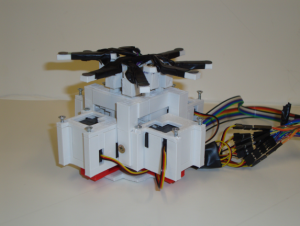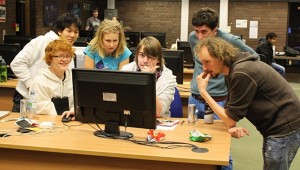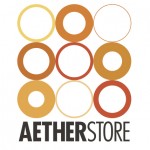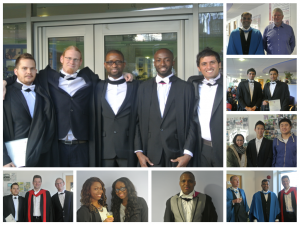phd
Funded PhD Research Studentships: Closing Date 15th December
A reminder that the closing date for applications is near. The School has funding for students to undertake PhD research in any of the general research areas in the school.
Are you a highly motivated student with an interest in these exciting research areas. A list of specific potential projects may help you decide. The studentships cover the cost of fees and an annual tax-free maintenance stipend. Exceptionally well-qualified students may be awarded an enhanced stipend.
For further information on how to apply, see our postgraduate web pages . We will make decisions on studentship allocation by February 27th 2015. Informal enquiries can be directed to pg-admin-cs@st-andrews.ac.uk or to potential supervisors.
PhD Viva Success
Congratulations to Dr Lei Fang, who passed his PhD viva yesterday. He is pictured below with Supervisor Professor Simon Dobson, External Examiner Dr Iain Bate from York University and Internal Examiner Dr Adam Barker.
AetherStore Software Defined Storage
Graduates Robert Macinnis, Allan Boyd and Angus Macdonald, the executive team behind AetherWorks, and distributed data storage solution AetherStore featured in The Register last week.
AetherWorks sponsored the St Andrews programming competition earlier this year. Further testament to the quality of our graduates, Lewis Headden and Isabel Peters have joined the successful start-up. We wish them all continued success as they near product delivery.
PhD Viva Success
Congratulations to Dr Graeme Stevenson, who passed his PhD viva earlier today. He is pictured below with supervisor Professor Simon Dobson and Internal Examiner Dr Graham Kirby. Professor Julie McCann from Imperial College, acted as External Examiner.
Finalist in Scottish Software Engineer of the Year
Congratulations to St Andrews student Simone Ivan Conte, who has been selected as one of the four finalists in the Young Software Engineer of the Year Award 2014.
Simone’s project (pictured below) involved creating a haptic device and API for displaying vector graphics (e.g., trees and graphs) for people with visual disabilities. According to his Senior Honours dissertation supervisor, Dr. Miguel Nacenta
this work demonstrates a lot of ingenuity and has a large potential impact.
The Young Software Engineer of the Year Awards are given for the best undergraduate software projects completed by students studying computer science and software engineering in Scotland.
Simone graduated in Computer Science from St Andrews earlier this year and is currently working for Adobe on a summer internship. In September he will start his doctoral studies, funded by Adobe, with Professor Alan Dearle at St Andrews.
Previous finalists and prize winners have included Thomas Grimes, Alistair Scott, Craig Paul, Angus MacDonald, Ben Catherall and Graeme Bell. Further testament to the quality of talented students graduating from the School of Computer Science.
The winners of this year’s award will be revealed on 2nd October 2014! Fingers crossed.
Ildiko Pete wins People’s Choice Prize
Congratulations to Ildiko Pete who won the People’s Choice Prize for her presentation at the 2014 London Hopper Colloquium. Ildiko entered the Research Spotlight competition prior to the event, and was chosen as a finalist. The event was held at the BCS headquarters on 22 May 2014.
The Colloquium is an annual event for women in Computer Science, which provides an opportunity for participants to present their work, network with other researchers and gain insights into careers in industry.
St Andrews Programming Competition 2014
The St Andrews Programming Competition 2014 is a friendly programming contest organised by the School of Computer Science for students belonging to all levels, coming from any background with any amount of programming experience. Team up with up to 3 members per team, compete for 3 hours by solving a set of programming problems using your favourite programming language and win £200 worth of prizes.
Generally, programming competitions are aimed at the best programmers, this is a first-of-its-kind competition where students from all levels with any amount of programming experience stand a chance to win a prize. Another unique aspect of this competition is that it has also open to members of staff from the School of Computer Science, making this a fun experience and a bonding opportunity for staff and students.
Students can use this opportunity gain valuable exposure to solving quick algorithmic programming questions – of the style that may come up in job interviews, where candidates are required to solve problems on the fly while being observed. Such interview practices are common among many companies nowadays including Google.
For more details and registration visit: http://goo.gl/I78Hyf
Facebook: www.facebook.com/stapc14
Twitter: @stapc14
If you have any questions, please email Shyam on smr20@st-andrews.ac.uk
The event, prizes and refreshments will be sponsored by AetherStore.
Event details
- When: 7th April 2014 14:00 - 17:00
- Where: Cole 0.35 - Subhons Lab
November Graduation 2013
Congratulations to the Masters Class of 2013, and PhD student Galhenage Perera, who graduated today. Students were invited to a reception in the school to celebrate their achievement with staff, friends and family. Our graduates have moved on to a wide variety of interesting and challenging employment and further study opportunities, and we wish them all well with their future careers.
PhD student awarded Google Scholarship
Many congratulations to Bilal Hussain, first year PhD student working with Dr Ian Miguel. Bilal has been awarded a Google Europe Scholarship for Students with Disabilities. We thank Google for their additional support for Bilal’s study and research. The main funding for Bilal’s PhD comes from the Engineering and Physical Sciences Research Council, and we of course thank them too.







